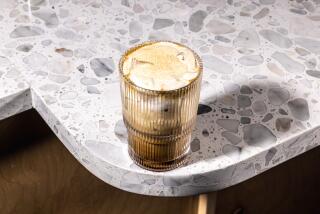Have a Java : Coffee Makers Try Iced Versions to Attract New Drinkers and Perk Up Sales
- Share via
As coffee consumption continues to grind down, manufacturers are pinning their hopes on something cold, sweet and canned to entice a new generation of beverage buffs to their ranks.
Iced coffees, they hope, will lure the youthful consumer to caffeine and allow coffee makers to compete with the $47-billion soft drink industry.
The early success of small manufacturers such as Jamaican Gold in San Francisco and P’Nosh Beverages Inc. in New York has paved the way for the debut later this year of an as-yet unnamed iced coffee from the Coca-Cola Nestle Refreshments Co. Kraft General Foods, still testing an iced coffee called Cappio in Phoenix, is unsure when it will release its product.
“Cold coffee represents a quantum jump for the industry,” said Ted Lingle, director of the Specialty Coffee Assn. in Los Angeles. “For the first time, the coffee industry can go head-to-head with the soft drink industry. We in the industry felt it was cold and sweet. People and particular fancy food consumers are fickle and bored quickly. It’s a nice beverage and people enjoy it.”
Ironically, the wholesale price of coffee is lower than it has been in nearly two decades, but the savings are not being passed on to consumers. The reason is that low price isn’t enough to lure the health conscious back to coffee, according to industry experts.
“The price of coffee for the consumer will remain fairly stable,” said Nestor Zarate, an independent coffee consultant in New York. “Retailers know that passing lower prices on to the consumer won’t create more demand for coffee.”
Manufacturers hope that innovation will.
“Expanding the coffee line and giving consumers different ways of drinking coffee has been our strategy for the last three or four years,” a spokeswoman for Kraft said.
Coffee drinking has dropped slowly since the 1960s, when Americans averaged three cups each day. Today, coffee lovers drink less than two cups, according to the National Coffee Assn. in New York.
So coffee manufacturers and small entrepreneurs have worked to expand the variety of choices for consumers, much like the soft drink industry with its wide array of flavors and sugar-free variations. Available now are premium blends, coffee bags, caffeine-free, caffeine-light, flavored and gourmet coffees.
“The multiples are mind-boggling and are contributing to the expansion of the coffee industry,” Lingle said. “Soon you’ll be able to have caffeine-free, flavored, gourmet coffees.”
And now there are iced coffees, which Lingle called the most popular of all the different new coffees because of their coolness and sweet taste. Most are mixed with cream and sugar, but variations include iced cappuccino and iced Thai coffee.
Coca-Cola Nestle Refreshments Co., based in Tampa, Fla., will introduce its coffee soft drink by the end of May. The company hopes to bring back the lost generation of coffee drinkers, said Tom Pirko, president of Bevmark Inc., a consulting firm in Los Angeles.
Kraft General Foods aims to attract young adults with their Cappio Iced Coffee, which will come in three flavors: coffee, mocha and cinnamon. The product will be distributed in packs of four eight- and 24-ounce bottles, a company spokeswoman said.
Gavina F. Sons Inc., a family-run coffee manufacturer based in Vernon, has found its niche by specializing in gourmet coffee and has flirted with the idea of producing coffee soft drinks. At A Taste of L.A. food fair last August, the company sold iced coffee in a booth, and Gavina also provides iced coffee recipes for coffee shops that purchase its coffee.
“If you look at the whole industry, our end of it isn’t that large, however it seems to be growing more and more each year,” said Leonore Gavina-Valls, co-owner of the company that has grown steadily by 20% for the past five years, with $26 million in sales last year.
Iced coffee is yet another transplant from Japan, where vending machines carry it canned and bottled. There coffee soft drinks make up a $7-billion industry.
“Iced coffee has been a popular drink for a while in Japan,” said Peter Zuckerman, manager of Pasqua Coffee and Panini Bar on Wilshire Boulevard. “And it’s becoming more of a subculture among Californians who still want the pump on hot afternoons.”
But college coffee houses, especially UCLA’s Kerckhoff Coffeehouse, have been instrumental testing grounds for the new product and will continue to be throughout the ‘90s, Lingle of the Specialty Coffee Assn. said.
The 16-year-old Coffeehouse has offered different kinds of iced cappuccino for the past seven years, said manager Roy Champawat.
“Quite a few (coffee houses) are opening in Orange County, and they’re going to be offering a greater variety and not just the iced cappuccino,” Lingle said. “They will lead the way and major manufacturers will follow with packaged products available in the supermarket.”
COFFEE PRICES GRIND DOWN
Although coffee consumption has dropped since the early 1980s, the average consumer price of 100% ground roast coffeee has fluctuated only slightly in that time. In 1991, American consumers paid about $2.81 for a pound of coffee when they paid $3.14 in 1980.
1991: $2.81
1986: $3.44
Source: U.S. Department of Labor
More to Read
Eat your way across L.A.
Get our weekly Tasting Notes newsletter for reviews, news and more.
You may occasionally receive promotional content from the Los Angeles Times.










